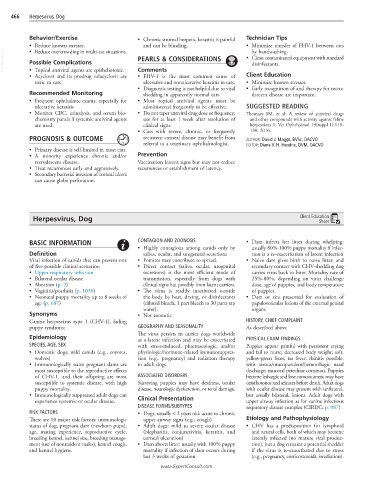Page 949 - Cote clinical veterinary advisor dogs and cats 4th
P. 949
466 Herpesvirus, Dog
Behavior/Exercise • Chronic stromal herpetic keratitis is painful Technician Tips
• Reduce known stresses. and can be blinding. • Minimize transfer of FHV-1 between cats
VetBooks.ir Possible Complications PEARLS & CONSIDERATIONS • Clean contaminated equipment with standard
by handwashing.
• Reduce overcrowding in multi-cat situations.
disinfectants.
• Topical antiviral agents are epitheliotoxic.
• Acyclovir and its prodrug valacyclovir are Comments Client Education
• FHV-1 is the most common cause of
toxic to cats. ulcerative and nonulcerative keratitis in cats. • Minimize known stresses.
• Diagnostic testing is not helpful due to viral • Early recognition of and therapy for recru-
Recommended Monitoring shedding in apparently normal cats. descent disease are important.
• Frequent ophthalmic exams, especially for • Most topical antiviral agents must be
ulcerative keratitis administered frequently to be effective. SUGGESTED READING
• Monitor CBC, urinalysis, and serum bio- • Do not taper antiviral drug dose or frequency; Thomasy SM, et al: A review of antiviral drugs
chemistry panels if systemic antiviral agents use for at least 1 week after resolution of and other compounds with activity against feline
are used. clinical signs. herpesvirus 1. Vet Ophthalmol 19(suppl 1):119-
• Cats with severe, chronic, or frequently 130, 2016.
PROGNOSIS & OUTCOME recurrent corneal disease may benefit from AUTHOR: David J. Maggs, BVSc, DACVO
referral to a veterinary ophthalmologist. EDITOR: Diane V. H. Hendrix, DVM, DACVO
• Primary disease is self-limited in most cats.
• A minority experience chronic and/or Prevention
recrudescent disease. Vaccination lessens signs but may not reduce
• Treat recurrences early and aggressively. recurrences or establishment of latency.
• Secondary bacterial invasion of corneal ulcers
can cause globe perforation.
Herpesvirus, Dog Client Education
Sheet
BASIC INFORMATION CONTAGION AND ZOONOSIS • Dam infects her litter during whelping:
• Highly contagious among canids only by usually 80%-100% puppy mortality if infec-
Definition saliva, ocular, and urogenital secretions tion is a re-exacerbation of latent infection
Viral infection of canids that can present one • Fomites may contribute to spread. • Naive dam gives birth to naive litter, and
of five possible clinical scenarios: • Direct contact (saliva, ocular, urogenital secondary contact with CHV-shedding dog
• Upper respiratory infection secretions) is the most efficient mode of carries virus back to litter. Mortality rate of
• Bilateral ocular disease transmission, especially from dogs with 25%-80%, depending on virus challenge
• Abortion (p. 2) clinical signs but possibly from latent carriers. dose, age of puppies, and body temperature
• Vaginitis/posthitis (p. 1030) • The virus is readily inactivated outside of puppies.
• Neonatal puppy mortality up to 8 weeks of the body by heat, drying, or disinfectants • Dam or sire presented for evaluation of
age (p. 687) (diluted bleach, 1 part bleach to 30 parts tap papulovesicular lesions of the external genital
water). organs
Synonyms • Not zoonotic
Canine herpesvirus type 1 (CHV-1), fading HISTORY, CHIEF COMPLAINT
puppy syndrome GEOGRAPHY AND SEASONALITY As described above
The virus persists in carrier dogs worldwide
Epidemiology as a latent infection and may be exacerbated PHYSICAL EXAM FINDINGS
SPECIES, AGE, SEX with stress-induced, pharmacologic, and/or Puppies appear painful with persistent crying
• Domestic dogs; wild canids (e.g., coyotes, physiologic/hormone-related immunosuppres- and fail to nurse; decreased body weight; soft,
wolves) sion (e.g., pregnancy) and radiation therapy yellow-green feces; no fever; rhinitis possible,
• Immunologically naive pregnant dams are in adult dogs. with serous/mucopurulent/hemorrhagic nasal
most susceptible to the reproductive effects discharge; mucosal petechiae common. Puppies
of CHV-1, and their offspring are most ASSOCIATED DISORDERS become lethargic and lose consciousness; may have
susceptible to systemic disease, with high Surviving puppies may have deafness, ocular opisthotonos and seizures before death. Adult dogs
puppy mortality. disease, neurologic dysfunction, or renal damage. with ocular disease may present with unilateral,
• Immunologically suppressed adult dogs can Clinical Presentation but usually bilateral, lesions. Adult dogs with
experience systemic or ocular disease. upper airway infection as for canine infectious
DISEASE FORMS/SUBTYPES respiratory disease complex (CIRDC; p. 987)
RISK FACTORS • Dogs, usually < 2 years old: acute to chronic
There are 10 major risk factors: immunologic upper airway signs (e.g., cough) Etiology and Pathophysiology
status of dog, pregnant dam (newborn pups), • Adult dogs: mild to severe ocular disease • CHV has a predisposition for lymphoid
age, mating experience, reproductive cycle, (blepharitis, conjunctivitis, keratitis, and and neural cells, both of which may become
breeding kennel, kennel size, breeding manage- corneal ulceration) latently infected (no mature viral produc-
ment (use of nonresident males), kennel cough, • Dam aborts litter: usually with 100% puppy tion), but a dog remains a potential shedder
and kennel hygiene. mortality if infection of dam occurs during if the virus is re-exacerbated due to stress
last 3 weeks of gestation (e.g., pregnancy, corticosteroids, irradiation).
www.ExpertConsult.com

